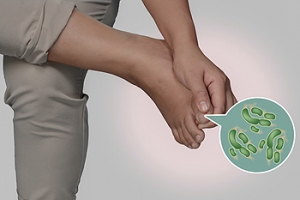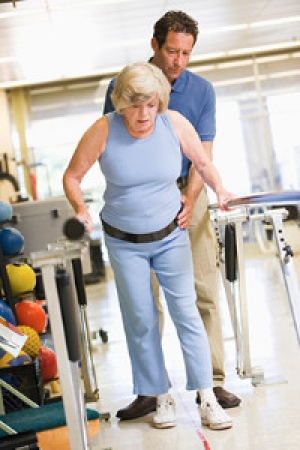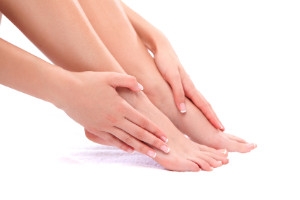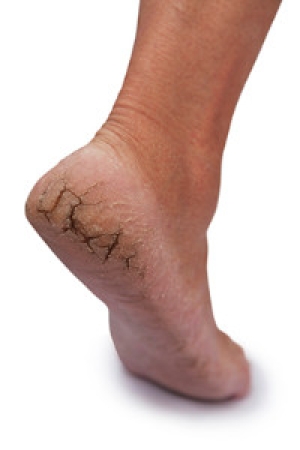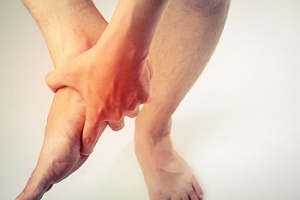
Signs You May Have Athlete’s Foot
 If you have noticed that your feet are scaling and itchy, you may have a condition that is referred to as athlete’s feet. The most common place of discomfort may occur in between the toes, and this may lead to the formation of blisters. This contagious fungal infection typically thrives in moist places including public pools and shower floors. There are several symptoms that are associated with this uncomfortable condition including peeling skin, a burning sensation on the soles of the feet or in between the toes, in addition to severe itching. To prevent the onset of athlete's foot, it is suggested that appropriate shoes are worn in locker rooms, public pools, showers, and surrounding areas. Additionally, choosing to wear shoes that consist of breathable materials may aid in controlling this condition. Cotton socks may absorb any excess sweat that exists, and this may help to maintain a level of comfort. Please consult with a podiatrist if you are afflicted with athlete’s foot to learn about correct treatment techniques that are right for you.
If you have noticed that your feet are scaling and itchy, you may have a condition that is referred to as athlete’s feet. The most common place of discomfort may occur in between the toes, and this may lead to the formation of blisters. This contagious fungal infection typically thrives in moist places including public pools and shower floors. There are several symptoms that are associated with this uncomfortable condition including peeling skin, a burning sensation on the soles of the feet or in between the toes, in addition to severe itching. To prevent the onset of athlete's foot, it is suggested that appropriate shoes are worn in locker rooms, public pools, showers, and surrounding areas. Additionally, choosing to wear shoes that consist of breathable materials may aid in controlling this condition. Cotton socks may absorb any excess sweat that exists, and this may help to maintain a level of comfort. Please consult with a podiatrist if you are afflicted with athlete’s foot to learn about correct treatment techniques that are right for you.
Athlete’s Foot
Athlete’s foot is often an uncomfortable condition to experience. Thankfully, podiatrists specialize in treating athlete’s foot and offer the best treatment options. If you have any questions about athlete’s foot, consult with one of our podiatrists from The Podiatry Center, PC. Our doctors will assess your condition and provide you with quality treatment.
What Is Athlete’s Foot?
Tinea pedis, more commonly known as athlete’s foot, is a non-serious and common fungal infection of the foot. Athlete’s foot is contagious and can be contracted by touching someone who has it or infected surfaces. The most common places contaminated by it are public showers, locker rooms, and swimming pools. Once contracted, it grows on feet that are left inside moist, dark, and warm shoes and socks.
Prevention
The most effective ways to prevent athlete’s foot include:
- Thoroughly washing and drying feet
- Avoid going barefoot in locker rooms and public showers
- Using shower shoes in public showers
- Wearing socks that allow the feet to breathe
- Changing socks and shoes frequently if you sweat a lot
Symptoms
Athlete’s foot initially occurs as a rash between the toes. However, if left undiagnosed, it can spread to the sides and bottom of the feet, toenails, and if touched by hand, the hands themselves. Symptoms include:
- Redness
- Burning
- Itching
- Scaly and peeling skin
Diagnosis and Treatment
Diagnosis is quick and easy. Skin samples will be taken and either viewed under a microscope or sent to a lab for testing. Sometimes, a podiatrist can diagnose it based on simply looking at it. Once confirmed, treatment options include oral and topical antifungal medications.
If you have any questions, please feel free to contact our office located in Millburn, NJ . We offer the newest diagnostic and treatment technologies for all your foot care needs.
How to Deal with Athlete's Foot
Athlete’s foot is a type of fungal infection that affects the skin on the feet. It is caused when the tinea fungus grows on the foot. It is possible to catch the fungus through direct contact with someone who has it or by touching a surface that is contaminated with it. This type of fungus thrives in warm, moist environments such as showers, locker room floors, and swimming pools. Your risk of getting it may also increase by wearing tight-fitting, closed-toe shoes, or by having sweaty feet.
Symptoms of athlete’s foot include itching, stinging or burning sensations between the toes. You may also experience toenails that are discolored, thick, crumbly, or toenails that pull away from the nail bed.
Your podiatrist may diagnose athlete’s foot by detecting these symptoms or by doing a skin test to see if there is a fungal infection present. The most common exam used to detect Athlete’s foot is a skin lesion potassium hydroxide exam. To use this method, your doctor will scrape off a small area of the infected skin and place it into potassium hydroxide. The potassium hydroxide will destroy the normal cells and leave the fungal cells untouched so that they are visible under a microscope.
There are a variety of treatment options for athlete’s foot. Some medications are miconazole (Desenex), terbinafine (Lamisil AT), clotrimazole (Lotrimin AF), butenafine (Lotrimin Ultra), and tolnaftate (Tinactin). While these options may be able to treat your fungus, it is best that you consult with a podiatrist in order to see which treatment option may work best for you.
In some cases, Athlete’s foot may lead to complications. A severe complication would be a secondary bacterial infection which may cause your foot to become swollen, painful, and hot.
There are ways that you can prevent athlete’s foot. Washing your feet with soap and water each day and drying them thoroughly is an effective way to prevent infections. You also shouldn’t share socks, shoes, or towels with other people. It is crucial that you wear shower sandals in public showers, around swimming pools, and in other public places. Additionally, you should make sure you wear shoes that can breathe and change your socks when your feet become sweaty. If you suspect that you have Athlete’s foot, you should seek help from a podiatrist as soon as possible.
Simple Adjustments to Prevent Falling
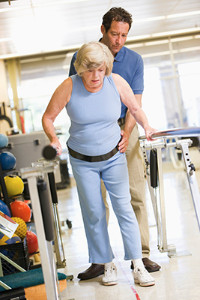 Many people have found that making simple adjustments in the household may aid in preventing falls from occurring. These changes may include installing grab bars in the shower area, keeping the lighting bright in the house, repairing loose carpet, in addition to removing the majority of the clutter that may be present. Research has shown falling to be the number one cause of injuries in elderly people, and this may result in serious injuries. It can be a frightening experience, and many seniors may not engage in certain activities to prevent a fall from occurring. Additionally, it may be beneficial to live on one floor, which will eliminate the possibility of falling down any steps. When non-slip mats are used in the bath and shower areas, the risk of falling may be decreased. It’s important to pay close attention to any condition in the house, which may promote falling.
Many people have found that making simple adjustments in the household may aid in preventing falls from occurring. These changes may include installing grab bars in the shower area, keeping the lighting bright in the house, repairing loose carpet, in addition to removing the majority of the clutter that may be present. Research has shown falling to be the number one cause of injuries in elderly people, and this may result in serious injuries. It can be a frightening experience, and many seniors may not engage in certain activities to prevent a fall from occurring. Additionally, it may be beneficial to live on one floor, which will eliminate the possibility of falling down any steps. When non-slip mats are used in the bath and shower areas, the risk of falling may be decreased. It’s important to pay close attention to any condition in the house, which may promote falling.
Preventing falls among the elderly is very important. If you are older and have fallen or fear that you are prone to falling, consult with one of our podiatrists from The Podiatry Center, PC. Our doctors will assess your condition and provide you with quality advice and care.
Every 11 seconds, an elderly American is being treated in an emergency room for a fall related injury. Falls are the leading cause of head and hip injuries for those 65 and older. Due to decreases in strength, balance, senses, and lack of awareness, elderly persons are very susceptible to falling. Thankfully, there are a number of things older persons can do to prevent falls.
How to Prevent Falls
Some effective methods that older persons can do to prevent falls include:
- Enrolling in strength and balance exercise program to increase balance and strength
- Periodically having your sight and hearing checked
- Discuss any medications you have with a doctor to see if it increases the risk of falling
- Clearing the house of falling hazards and installing devices like grab bars and railings
- Utilizing a walker or cane
- Wearing shoes that provide good support and cushioning
- Talking to family members about falling and increasing awareness
Falling can be a traumatic and embarrassing experience for elderly persons; this can make them less willing to leave the house, and less willing to talk to someone about their fears of falling. Doing such things, however, will increase the likelihood of tripping or losing one’s balance. Knowing the causes of falling and how to prevent them is the best way to mitigate the risk of serious injury.
If you have any questions, please feel free to contact our office located in Millburn, NJ . We offer the newest diagnostic and treatment technologies for all your foot care needs.
Falls Prevention
Elderly Americans are very susceptible to falls as they get older. Everyone experiences decreases in flexibility, balance, strength, and the senses as they age. This correlates to some eye-opening statistics. 1 in 4 Americans aged 65 and older fall each year. An elderly American is being treated for a fall in an emergency room every 11 seconds. In light of these striking statistics, one can see the importance of taking steps to prevent falls.
Finding an exercise program for the elderly is an excellent way to reduce the likelihood of falls. Look for an exercise program that improves strength and balance. Elderly people who live a more sedentary lifestyle, with little physical activity, are at an increased risk of falling. Wearing well-fitted footwear that provides good foot support and cushion will help prevent falls from poorly fitted shoes. Talking to a podiatrist about your susceptibility to falls and about inspecting your prescriptions will help to avoid any medication that could make falls more likely. Due to a decline in the senses among the elderly, having your eyes and hearing checked is recommended.
Around half of all falls occur in the household. Removing tripping hazards in the home and making it more accommodating to older persons can significantly reduce falls. Some notable household changes include increasing lighting around the house, installing grab bars in the shower and bathroom, and making sure the floor is clear of clutter. Other smart options include installing a shower chair, using rubber-bottomed rugs, and placing railings on both sides of stairwells.
Finally, discuss with a doctor and your family about your fear of falling. This will help to increase awareness among the population on the need for fall prevention. A lack of awareness on the matter, and a downplaying of importance are what increase the risks of falling. Following these tips can help to reduce the risk for yourself and your loved ones.
Tracing Your Foot May Aid in Determining the Correct Shoe Size
 Most people have feet that are two different sizes. It’s important to use proper techniques for determining the correct shoe size, and this may aid in preventing uncomfortable foot conditions from developing. This often includes ensuring there is adequate room for the toes to move about freely in, and the feet will benefit by wearing shoes that bend at the ball of the foot. Research has shown the best time of day to purchase shoes is at the end of the day when the feet may be the largest. An accurate shoe measurement can be obtained by tracing your foot on a piece of paper, while wearing socks that you would most likely wear daily. When the foot is traced with a pencil that is held in an upright position, the measurement may be more accurate than if the pencil is angled as this process occurs. After completing this, the shoe size to be determined is by the foot that is the largest and longest. If you would like additional information about how to properly measure your feet so the correct size shoes can be worn, it’s suggested to speak with a podiatrist.
Most people have feet that are two different sizes. It’s important to use proper techniques for determining the correct shoe size, and this may aid in preventing uncomfortable foot conditions from developing. This often includes ensuring there is adequate room for the toes to move about freely in, and the feet will benefit by wearing shoes that bend at the ball of the foot. Research has shown the best time of day to purchase shoes is at the end of the day when the feet may be the largest. An accurate shoe measurement can be obtained by tracing your foot on a piece of paper, while wearing socks that you would most likely wear daily. When the foot is traced with a pencil that is held in an upright position, the measurement may be more accurate than if the pencil is angled as this process occurs. After completing this, the shoe size to be determined is by the foot that is the largest and longest. If you would like additional information about how to properly measure your feet so the correct size shoes can be worn, it’s suggested to speak with a podiatrist.
Finding a properly-fitting shoe is important in reducing injuries and preventing foot problems. For more information about treatment, contact one of our podiatrists from The Podiatry Center, PC. Our doctors will treat your foot and ankle needs.
Proper Shoe Fitting
A common concern when it comes to foot health, having properly fitted shoes can help prevent injuries to the foot. Out feet affect our posture and gait, which in turn affects the biomechanics and overall bodily structure. With 33 joints, 26 bones, and over 100 ligaments, the potential for serious injury is much greater than one realizes. Although the feet cease growth in adulthood, they still change shape as they mature. Here are some factors to consider when it comes to investing in proper fitting shoes:
- Be sure the shoes fit correctly right away
- Ensure the ball of your foot fits comfortably in the widest portion of the shoes
- Even though they may look fashionable, improper fitting shoes can either create adverse conditions or exacerbate existing ones you may already have
- Walk along a carpeted surface to ensure the shoes comfortably fit during normal activity
Keeping in mind how shoes fit the biomechanics of your body, properly-fitting shoes are vitally important. Fortunately, it is not difficult to acquire footwear that fits correctly. Be sure to wear shoes that support the overall structure of your body. Do your feet a favor and invest in several pairs of well-fitted shoes today.
If you have any questions please feel free to contact our office located in Millburn, NJ . We offer the newest diagnostic and treatment technologies for all your foot and ankle needs.
How to Get a Proper Shoe Fit
Many people suffer from foot problems because their shoes are poorly fitted. When shopping for a new pair of shoes, fashion usually triumphs over comfortability. A pair of well fitted shoes is essential in preventing foot problems and potential injuries.
Poorly fitted shoes can cause foot issues such as plantar fasciitis, bunions, hammertoes, ingrown toenails, and foot pain. Shoes such as high heels and sandals may cause problems for your feet. These shoes put the foot in an unnatural position for long periods and fail to provide good foot support. It is recommended to not wear either one for an extended period.
When you are trying on shoes, make sure they have enough space for your toes to move around. Shoes shouldn’t be cramped but also shouldn’t have too much room that your foot moves around in them. A snug shoe is a good choice. They should also provide good arch support and cushioning. Athletic shoes tend to offer both good support and cushioning. A degree of flexibility is necessary so they aren’t too stiff or too unsupportive.
If you can wear your shoes for a long period of time without experiencing any discomfort, this is a sign that your shoes fit properly. Do not be too dismayed if the shoe isn’t a perfect fit at first; many shoes take a few days to weeks to properly break in. However don’t expect an uncomfortable shoe to become fitted to your foot.
For those with foot conditions such as flat feet or pronation, orthotics may be helpful or even necessary to prevent foot pain. Orthotics are inserts that are placed in the shoe and provide support and cushioning for the foot. While there are many types of orthotics out there, custom-made orthotics may be necessary depending upon your foot and foot conditions.
Feet change in size over time. It is important to check your foot size over time so that you can make sure you have the perfect fit for your feet. A podiatrist can provide more information on proper shoe fitting and foot orthotics.
What Is The Most Common Cause Of Cracked Heels?
 Some authorities have determined that cracked heels may develop as a result of the lack of attention the skin on the heels generally gets. There are many causes why this condition may occur, and having dry skin is generally the most common reason why this ailment may develop. Additionally, if the heels should endure excess pressure from being overweight, the chances of developing cracked heels may increase. There may also be a vitamin deficiency in the body, which may lead to the formation of heel fissures. If you stand for the majority of the day or frequently wear open-back sandals, the skin on the heels may gradually become dry and may lead to this uncomfortable condition. Partial relief may be obtained in washing and drying the feet thoroughly, followed by utilizing a good moisturizer. If you have this condition, please counsel with a podiatrist to learn about preventive measures and additional treatment options for cracked heels.
Some authorities have determined that cracked heels may develop as a result of the lack of attention the skin on the heels generally gets. There are many causes why this condition may occur, and having dry skin is generally the most common reason why this ailment may develop. Additionally, if the heels should endure excess pressure from being overweight, the chances of developing cracked heels may increase. There may also be a vitamin deficiency in the body, which may lead to the formation of heel fissures. If you stand for the majority of the day or frequently wear open-back sandals, the skin on the heels may gradually become dry and may lead to this uncomfortable condition. Partial relief may be obtained in washing and drying the feet thoroughly, followed by utilizing a good moisturizer. If you have this condition, please counsel with a podiatrist to learn about preventive measures and additional treatment options for cracked heels.
Cracked heels are unsightly and can cause further damage to your shoes and feet. If you have any concerns, contact one of our podiatrists from The Podiatry Center, PC. Our doctors can provide the care you need to keep you pain-free and on your feet.
Cracked Heels
Cracked heels appear unappealing and can make it harder for you walk around in sandals. Aside from looking unpleasant, cracked heels can also tear stockings, socks, and wear out your shoes. There are several methods to help restore a cracked heel and prevent further damage.
How Do You Get Them?
Dry skin is the number one culprit in creating cracked heels. Many athletes, walkers, joggers, and even swimmers suffer from cracked heels. Age and skin oil production play a role to getting cracked heels as well.
Promote Healing
Over the counter medicines can help, especially for those that need instant relief or who suffer from chronic dry feet.
Wear Socks – Wearing socks with medicated creams helps lock in moisture.
Moisturizers – Applying both day and night will help alleviate dryness which causes cracking.
Pumice Stones – These exfoliate and remove dead skin, which allows for smoother moisturizer application and better absorption into the skin.
Change in Diet
Eating healthy with a well-balanced diet will give the skin a fresh and radiant look. Your body responds to the kinds of food you ingest. Omega-3 fatty acids and zinc supplements can also revitalize skin tissue.
Most importantly, seek professional help if unsure how to proceed in treating cracked heels. A podiatrist will help you with any questions or information needed.
If you have any questions, please feel free to contact our office located in Millburn, NJ . We offer the newest diagnostic and treatment technologies for all your foot care needs.
Solutions for Cracked Heels
Cracked heels may make you want to think twice about showing off your feet in warmer weather. However, cracked heels may be harmful to more than just the appearance of your feet. If deep fissures and cracks develop in your heels, they may make walking and standing painful for you. Additionally, these openings make way for germs to enter through your skin and cause infection.
There are several different causes of cracked heels. One of the most common reasons for this ailment is dry skin. This problem may make your keeps feel rough tight and itchy. Dry skin may be caused by cold air, extremely hot water, harsh soaps, and aging. Skin disorders such as eczema and psoriasis may eventually lead to dry skin. In some cases, complications may arise from cracked heels. Some of these complications are a loss of feeling in the heel, cellulitis, or a diabetic foot ulcer.
There are ways you can try to prevent getting cracked heels. One of the best ways to do so is to avoid wearing flip flops and sandals because these shoes increase your risk of drying out your feet. You should also avoid wearing shoes with a tall skinny heel, because these shoes cause your heel to expand sideways. At night, you should slather on a thick moisturizing cream on your feet and then cover them in socks to keep your feet moisturized overnight. Drinking water to stay hydrated is also a good way to ensure that your skin doesn’t become dry.
If you suffer from a severe case of cracked feet, you should make an appointment with your podiatrist to see what treatment methods are best for you.
What are Achilles Tendon Injuries
The Achilles tendon is the strongest tendon in the human body. Its purpose is to connect the lower leg muscles and calf to the heel of the foot. This tendon is responsible for facilitating all types of movement, like walking and running. This tendon provides an enormous amount of mobility for the body. Any injuries inflicted to this tissue should be immediately brought up with a physician to prevent further damage.
The most common injuries that can trouble the Achilles tendon are tendon ruptures and Achilles tendinitis. Achilles tendinitis is the milder of the two injuries. It can be recognized by the following symptoms: inflammation, dull-to-severe pain, increased blood flow to the tendon, thickening of the tendon, and slower movement time. Tendinitis can be treated via several methods and is often diagnosed by an MRI.
An Achilles tendon rupture is trickier to heal, and is by far the most painful injury. It is caused by the tendon ripping or completely snapping. The results are immediate and absolutely devastating, and will render the patient immobile. If a rupture or tear occurs, operative and non-operative methods are available. Once the treatment begins, depending on the severity of the injury, recovery time for these types of issues can take up to a year.
Simple preventative measures can be taken as a means to avoid both injuries. Prior to any movement, taking a few minutes to stretch out the tendon is a great way to stimulate the tissue. Calf raises, squats, leg curls, leg extensions, leg raises, lunges, and leg presses are all suggested ways to help strengthen the lower legs and promote Achilles tendon health.
Many problems arise among athletes and people who overexert themselves while exercising. Problems can also happen among those who do not warm up properly before beginning an activity. Proper, comfortable shoes that fit correctly can also decrease tendon injuries. Some professionals also suggest that when exercising, you should make sure that the floor you are on is cushioned or has a mat. This will relieve pressure on the heels. A healthy diet will also increase tendon health.
It is very important to seek out a podiatrist if you believe you have an injury in the Achilles region. Further damage could result in severe complications that would make being mobile difficult, if not impossible.
Where is Pain from Tarsal Tunnel Syndrome Located?
 If you have pain that is located on the inside of the ankle and foot, you may be experiencing an uncomfortable foot condition that is known as tarsal tunnel syndrome. This condition occurs when the nerves in this area of the foot become damaged and will typically cause severe inflammation. It may develop as a result of walking, running or standing for extended periods of time, or possibly from a serious injury that the foot endures. There may be effective treatment options that may provide partial relief, including performing gentle stretching exercises, resting and elevating the foot, or minimizing any foot pressure that is present. This may often include wearing shoes that are fit looser, which may aid in reducing any tightness around the foot. It is strongly suggested to speak with a podiatrist if you are experiencing this type of foot pain who can aid in properly treating this painful foot condition.
If you have pain that is located on the inside of the ankle and foot, you may be experiencing an uncomfortable foot condition that is known as tarsal tunnel syndrome. This condition occurs when the nerves in this area of the foot become damaged and will typically cause severe inflammation. It may develop as a result of walking, running or standing for extended periods of time, or possibly from a serious injury that the foot endures. There may be effective treatment options that may provide partial relief, including performing gentle stretching exercises, resting and elevating the foot, or minimizing any foot pressure that is present. This may often include wearing shoes that are fit looser, which may aid in reducing any tightness around the foot. It is strongly suggested to speak with a podiatrist if you are experiencing this type of foot pain who can aid in properly treating this painful foot condition.
Tarsal tunnel syndrome can be very uncomfortable to live with. If you are experiencing tarsal tunnel syndrome, contact one of our podiatrists of The Podiatry Center, PC. Our doctors can provide the care you need to keep you pain-free and on your feet.
Tarsal Tunnel Syndrome
Tarsal tunnel syndrome, which can also be called tibial nerve dysfunction, is an uncommon condition of misfiring peripheral nerves in the foot. The tibial nerve is the peripheral nerve in the leg responsible for sensation and movement of the foot and calf muscles. In tarsal tunnel syndrome, the tibial nerve is damaged, causing problems with movement and feeling in the foot of the affected leg.
Common Cause of Tarsal Tunnel Syndrome
- Involves pressure or an injury, direct pressure on the tibial nerve for an extended period of time, sometimes caused by other body structures close by or near the knee.
- Diseases that damage nerves, including diabetes, may cause tarsal tunnel syndrome.
- At times, tarsal tunnel syndrome can appear without an obvious cause in some cases.
The Effects of Tarsal Tunnel Syndrome
- Different sensations, an afflicted person may experience pain, tingling, burning or other unusual sensations in the foot of the affected leg.
- The foot muscles, toes and ankle become weaker, and curling your toes or flexing your foot can become difficult.
- If condition worsens, infections and ulcers may develop on the foot that is experiencing the syndrome.
A physical exam of the leg can help identify the presence of tarsal tunnel syndrome. Medical tests, such as a nerve biopsy, are also used to diagnose the condition. Patients may receive physical therapy and prescriptive medication. In extreme cases, some may require surgery.
If you have any questions please feel free to contact our office located in Millburn, NJ . We offer the newest diagnostic and treatment technologies for all your foot and ankle needs.
